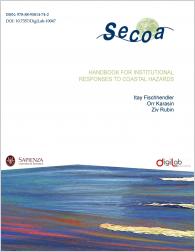
FREE VERSION DOWNLOAD
Open access work licensed to the public under a Creative Commons Attribution 3.0 Italia license (CC BY-NC-ND).
Opera diffusa in modalità open access e sottoposta a licenza Creative Commons Attribuzione – Non commerciale - Non opere derivate (CC BY-NC-ND), 3.0 Italia
Weather-related disasters continue to increase in frequency, many of which occur along the coast. These events claim the lives of many and have a detrimental effect on the quality of life of others. To address these risks, institutions are established with the aim of enhancing the resiliency of vulnerable coastal communities to natural disasters. Given the role of these institutions, the objective of this handbook is to understand how such institutions respond to natural disasters. This will be conducted through a cross-country comparative case study of institutional responses to vulnerability to natural coastal hazards. In particular the study asks: What is social and institutional vulnerability to natural hazards?; What institutions are available to address vulnerability to coastal hazards?; What are the reasons for the formation of the aforementioned institutions?; and What are the non-monetary costs associated with the institutional response to natural hazards? The study reveals that the incentive to establish an institutional response stems from a physical or institutional trigger and that the formation of institutional response mechanisms is gradual. Given the political cost of dismantling existing institutions, the organizational body most likely to be established is a local or central governmental body that coordinates the activities of existing institutions by establishing specialized inter-governmental committees. This implies that newly-established institutions (with both fiscal and regulatory independence) are to be expected, which is not always the case. Once it is decided to establish a new institution, its design leads to considerable conflict. These conflicts are most likely to erupt over budget allocation, cost estimation, and the eventual implementation speed (rapid vs. slow) of the response. The ultimate repercussion of such conflict is as expected, the complete termination of the response process.
eBook disponibile anche su Google Play, Google Libri, MLOL



